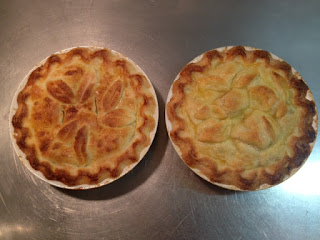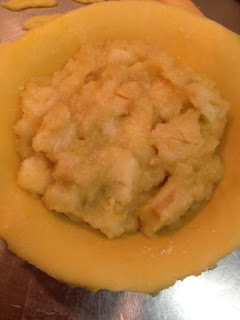Apple pie is my favourite thing to make (and eat) with Bramley apples (this link includes updated information on how to get them in Japan), with
a crumbly double pie-crust made with simple all-butter shortcrust pastry, or a
rich sweet shortcrust pastry. As I rave about excitedly in my first Bramleys in Japan post, British style apple pie made with Bramley cooking apples is tarter than American apple pie, and the apples end up as more of a fluffy puree rather than clearly defined slices. It is the taste from the tree in my childhood house.
 |
| Pre-cooked filling on left, apple slice filling on right |
Working from a basic recipe you can add all kinds of things to the filling
(sultanas, nuts, cinnamon cloves, a splash or steeping of a choice alcohol,
lemon or orange zest, some flour or cornflour if you find your apples produce too
much juice, caramel sauce, marzipan..) and/or to the pastry itself (ground
almonds or hazelnuts, cheddar cheese, a little baking powder, spices...).
Depending on the type of dish you use, the nature of your oven and how you want
your pie too look, you will also be able to change the amount of ingredients,
cooking times, and temperatures.
To get started with a basic recipe, you’ll need roughly 500g of shortcrust
pastry and 700g of Bramley apples (about 2 large ones) for a 22 cm pie dish. I
used about 500g of apples for each of the 18 cm shallow-dish pies in this post.
Sweet shortcrust pastry (about 500g)
- 275g flour
- 175g chilled butter, diced
- Pinch of salt
- 25g sugar
- 1 egg, beaten
- 2 tablespoons of cold water
Pie filling
- About 700g of Bramley apples for a 22cm pie dish
- Squeeze of lemon juice
- Between 0 - 100g of sugar, depending how tart your apples/sweet your tooth
- 25g of butter, diced
- Any additional ingredients of your choosing (spices, nuts etc..)
For the pastry, sift the flour and salt and rub the cold butter into flour briefly, until there are no very large lumps of butter left, stir in the sugar. Mix in the beaten egg and cold water with a round bladed knife and bring the dough together into a flat disc with your hands. Wrap in plastic and chill for at least 30 minutes, bringing it out of the fridge again 15 mins or so before you need to roll it out so that it's still cold but not solid to roll. Top tip! - if the sweet pastry misbehaves when rolling, try rolling it between two lightly floured sheets of plastic wrap, peeling them away carefully when you line the pie dish. Prick the base with a fork, scatter with ground almonds (optional) and leave the pastry hanging over the edge until you place the lid.
For the filling you can either peel and core the apples, cut them into
chunks and -
a) heat them through in a saucepan with the lemon juice, sugar and butter
until they start to soften into a puree to use in the filling (some chunks of
apple left in the puree are fine, and desirable.) Be sure to let your puree cool completely
before using so that you don’t prematurely melt the butter in the bottom crust
of the pie (1st photo), or you can -
b) toss them in some lemon juice and sugar and pile them in the
pastry-lined pie dish as raw chunks with little bits of butter dotted over them
before putting the pastry lid on the pie (2nd photo).
With your preferred filling in place, wet around the edges of the bottom
crust and lift your lid on top. Cut a couple of slits or holes for air vents and
press down gently around the edge of the lid to secure it and push out the air.
Hold your dish like a waiter with a tray, and slice off the over-hanging crust
(if you love lots of crust, you could instead fold the lid and overhang under
itself, a bit more American-style pie maybe? Nice link here on American-style crimping and tips on lattice top pies too).
Crimp edges or press down around the edge with a fork to make a pattern, and decorate to your heart's content with the pastry trimmings - my favourite part when I was little. You can freeze/chill the pie at this point for later baking, or brush the finished pie with milk (which I prefer) or egg wash (as used in these examples), sprinkle with sugar and bake. My little pies for this post took 25 minutes at 190°C, a 22 cm pie will probably be closer to 40 minutes.
Crimp edges or press down around the edge with a fork to make a pattern, and decorate to your heart's content with the pastry trimmings - my favourite part when I was little. You can freeze/chill the pie at this point for later baking, or brush the finished pie with milk (which I prefer) or egg wash (as used in these examples), sprinkle with sugar and bake. My little pies for this post took 25 minutes at 190°C, a 22 cm pie will probably be closer to 40 minutes.
If you are using the raw fruit method in particular, you will need to use
quite a hot oven temperature (190-220°C) to get the pieces of fruit to go soft
inside the pie. Be ready with some foil to drape over the top of the pie (or
fold loosely around the edges of the pie) if you notice the pastry browning too
quickly on top - this is a particular problem with small ovens used in Japan, as
your pie will take up most of the space in the oven and be quite close to the
oven roof.
 |
| No, these aren't the ideal dishes for baking pie... |
The differences between the two methods of preparing the filling are that
the pre-cooked filling (on the left) is a flatter pie with a more dense and jammy filling,
whereas the raw fruit method (on the right-side) gives a more dome-like shape, often with pockets of
space under the top crust of the pie as the Bramley apple pieces mush somewhat
during baking and reduce in size. It makes for a rustic, bobbly appearance to
the lid of the pie, and probably also helps to prevent soggy-bottomed pastry, as
the filling only becomes wet with juice after the pastry base already has had
time to bake.
Heating up the baking tray in advance in a hot 220°C or so oven, ahead of
reducing the temperature to your normal baking temperature, will also help to
cook the bottom crust properly for either filling method. Using an enamel pie
dish will also help you get a good bake on the base, and if you use a glass dish
you'll be able to see at any point how well the base is doing.
If you have pastry left over you could make jam tarts or mince pies! (Which is another fine use for Bramleys...)
 |
| Mini mince pies with homemade Christmas mincemeat filling |
Making up a double batch of the sweet shortcrust pastry isn't a bad idea as it keeps for a 3
days in the fridge, and freezes well for up to 3 months.
--
--
Here are a few good alternative pastry recipes that work well with apple
pie:
Classic plain shortcrust, half fat to flour, no
sugar. Good photos:
http://www.deliaonline.com/how-to-cook/baking/how-to-make-shortcrust-pastry.html
Sweet shortcrust made with icing sugar, butter, eggs and milk:
http://www.deliaonline.com/how-to-cook/baking/how-to-make-shortcrust-pastry.html
Sweet shortcrust made with icing sugar, butter, eggs and milk:
http://www.jamieoliver.com/recipes/pastry-cake/old-fashioned-sweet-shortcrust-pastry
French-style sweet pastry made with the creaming method:
French-style sweet pastry made with the creaming method:
http://www.bbc.co.uk/food/recipes/pate_sucree_39572
Cheddar cheese crust apple pie recipe from Delia Smith:
Cheddar cheese crust apple pie recipe from Delia Smith:















